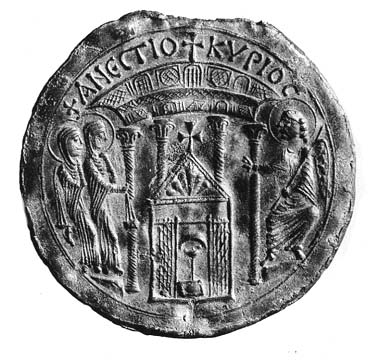Image Details

Dumbarton Oaks, Washington, D.C.
The sacred made portable. Pilgrims to the Holy Land used this tiny (less than 2 inches in diameter) tin-lead flask, decorated with an image of the three women at the Tomb, to carry home oil taken from the lamps hanging above Jesus’ Tomb. Such mementoes, known as eulogiai (Greek, “blessings”), allowed pilgrims to bring the sanctity of the holy sites with them wherever they went.
This sixth-century flask offers a rare image of the Rotunda and Tomb built by Constantine. Directly below the inscription, which reads “the Lord is risen,” is a row of windows cut into the dome of the Rotunda. Four large columns support the dome. Between them stands Jesus’ Tomb, with its triangular gable. On either side of the Tomb entrance is grillwork. The crescent shape inside the door probably represents the low entryway of the inner Tomb chamber. Inside appears an oil lamp on a stand; the slab on the ground may represent the stone that sealed the Tomb of Jesus.
